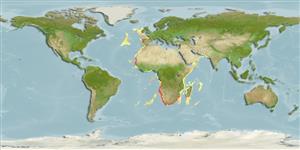Common names from other countries
Élasmobranches (requins et raies) (sharks and rays) >
Rajiformes (Skates and rays) >
Rajidae (Skates)
Etymology: Rajella: Latin, raja, -ae = a sting ray (Raja sp.) (Ref. 45335).
Issue
Specific name amended to R. leoparda in accordance with ICZN Article 34.2 by Weigmann et al., 2014 (Ref.96993).
Environment: milieu / climate zone / depth range / distribution range
Écologie
marin bathydémersal; profondeur 130 - 1920 m (Ref. 106604). Deep-water; - 36°S
Eastern Atlantic: off eastern and western South Africa to off Mauritania
Taille / Poids / Âge
Maturity: Lm ? range ? - ? cm
Max length : 95.0 cm TL mâle / non sexé; (Ref. 106604)
Description synthétique
Clés d'identification | Morphologie | Morphométrie
Large skate with a moderately long snout, small eyes, and a flat disc; tail about as long as body; small inconspicuous, light thorns on upper surface including snout (Ref. 5578). Medium grey to brownish dorsally, often with dark spots; white or mottled with dusky patches ventrally (Ref. 5578).
Found in deeper shelf and slope waters (Ref. 4426). Feed on bottom crustaceans, dragonets, rattails, hake, lanternfish, sea pens, cuttlefish and polychaete worms (Ref. 5578). Oviparous. Distinct pairing with embrace. Young may tend to follow large objects, such as their mother (Ref. 205). Eggs are oblong capsules with stiff pointed horns at the corners deposited in sandy or muddy flats (Ref. 205). Egg capsules are 7.4 cm long and 7.4 cm wide (Ref. 41249). Caught by hake trawlers (Ref. 5578).
Life cycle and mating behavior
Maturities | Reproduction | Spawnings | Egg(s) | Fecundities | Larves
Oviparous, paired eggs are laid. Embryos feed solely on yolk (Ref. 50449). Distinct pairing with embrace. Young may tend to follow large objects, such as their mother (Ref. 205).
McEachran, J.D. and K.A. Dunn, 1998. Phylogenetic analysis of skates, a morphologically conservative clade of elasmobranchs (Chondrichthyes: Rajidae). Copeia 1998(2):271-290. (Ref. 27314)
Statut dans la liste rouge de l'IUCN (Ref. 130435)
CITES (Ref. 128078)
Not Evaluated
Menace pour l'homme
Harmless
Utilisations par l'homme
Pêcheries: commercial
Outils
Articles particuliers
Télécharger en XML
Sources Internet
Estimates based on models
Preferred temperature (Ref.
115969): 4.1 - 11.9, mean 6.9 (based on 47 cells).
Phylogenetic diversity index (Ref.
82804): PD
50 = 0.5000 [Uniqueness, from 0.5 = low to 2.0 = high].
Bayesian length-weight: a=0.00309 (0.00191 - 0.00501), b=3.33 (3.20 - 3.46), in cm Total Length, based on LWR estimates for this species & (Sub)family-body (Ref.
93245).
Niveau trophique (Ref.
69278): 3.9 ±0.63 se; based on food items.
Résilience (Ref.
120179): Faible, temps minimum de doublement de population : 4,5 à 14 années (Fec assumed to be <100).
Fishing Vulnerability (Ref.
59153): High vulnerability (58 of 100).
